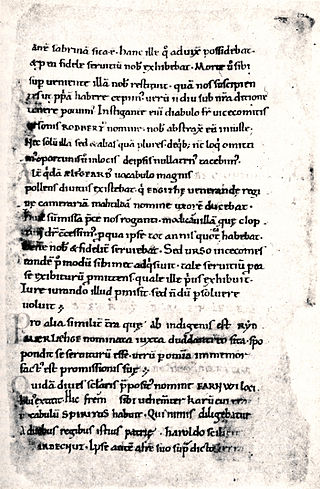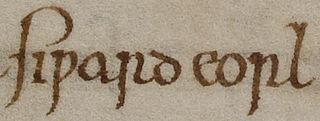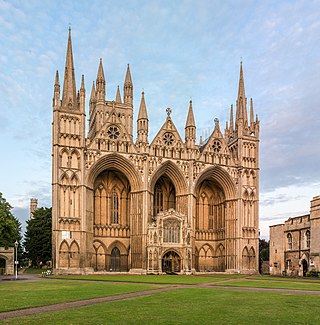
Leofric (died 31 August or 30 September 1057) was an Earl of Mercia. He founded monasteries at Coventry [1] and Much Wenlock and was a very powerful earl under King Cnut and his successors. Leofric was the husband of Lady Godiva.

Leofric (died 31 August or 30 September 1057) was an Earl of Mercia. He founded monasteries at Coventry [1] and Much Wenlock and was a very powerful earl under King Cnut and his successors. Leofric was the husband of Lady Godiva.
Leofric was the son of Leofwine, Ealdorman of the Hwicce, [1] who witnessed a charter in 997 for King Æthelred II. Leofric had three brothers: Northman, Edwin and Godwine. It is likely that Northman is the same as Northman Miles ("Northman the knight") to whom King Æthelred II granted the village of Twywell in Northamptonshire in 1013. [2] Northman, according to the Chronicle of Crowland Abbey, the reliability of which is often doubted by historians, says he was a retainer (knight) of Eadric Streona, the Earl of Mercia. [3] It adds that Northman was killed on Cnut's orders along with Eadric and others. [3] Cnut then "made Leofric ealdorman in place of his brother Northman, and afterwards held him in great affection". [4]
Becoming Earl of Mercia, which occurred sometime before 1032, [1] made him one of the most powerful men in King Cnut's court, second only to the ambitious Earl Godwin of Wessex. Leofric may have had some connection by marriage to Ælfgifu of Northampton, the first wife of Cnut, which might help to explain why he was the chief supporter of her son Harold Harefoot against Harthacnut, Cnut's son by Emma of Normandy, during the succession crisis after Cnut's death in 1035. [5] However, Harold died in 1040 and was then succeeded by his brother Harthacnut, who made himself unpopular by implementing heavy taxation during his short reign. Two of his tax-collectors were killed at Worcester by angry locals. The king was so enraged by this that in 1041 he ordered Leofric and his other earls to plunder and burn the city, and lay waste to the surrounding area. [6] This command must have tested Leofric's loyalty, since Worcester was the cathedral city of the Hwicce, his people.
When Harthacnut suddenly died in 1042, he was succeeded by his half-brother Edward the Confessor. Leofric loyally supported Edward when he came under threat at Gloucester, from Earl Godwin, in 1051. Leofric and Earl Siward of Northumbria gathered a great army to meet Godwin. Edward's advisors counseled him that battle would be folly, as there'd be important members of the nobility on both sides; the loss of these men, should many die in battle, would leave England open to its enemies. In the end the issue was resolved by less violent means; in accordance with Leofric's advice the settlement of the dispute was referred to the Witenagemot, [1] and Earl Godwin and his family were outlawed for a time. Earl Leofric's power was then at its height, but in 1055 Leofric's own son Ælfgar was outlawed, "without any fault", says the Anglo-Saxon Chronicle . Ælfgar raised an army in Ireland and Wales and brought it to Hereford, where he clashed with the army of Earl Ralph of Herefordshire and severely damaged the town. The Anglo-Saxon Chronicle wryly comments "And then when they had done most harm, it was decided to reinstate Earl Ælfgar".
Leofric died in 1057 at his estate at Kings Bromley in Staffordshire. According to the Anglo-Saxon Chronicle, he died on 30 September, but the chronicler of Worcester gives the date as 31 August. Both agree that he was buried in Coventry at St Mary's Priory and Cathedral. [7] Leofric was succeeded by his son Ælfgar as earl.
Earl Leofric and Godiva were noted for great generosity to religious houses. In 1043 he founded and endowed a Benedictine monastery at Coventry. [8] John of Worcester tells us that "He and his wife, the noble Countess Godgifu, a worshipper of God and devout lover of St Mary ever-virgin, built the monastery there from the foundations out of their own patrimony, and endowed it adequately with lands and made it so rich in various ornaments that in no monastery in England might be found the abundance of gold, silver, gems and precious stones that was at that time in its possession." [7]
In the 1050s Leofric and Godiva appear jointly as benefactors in a document granting land to the monastery of St Mary, Worcester, [9] and the endowment of the minster at Stow St Mary, Lincolnshire. [10] They are commemorated as benefactors of other monasteries as well, at Leominster, Chester, Much Wenlock, and Evesham. [7]
Apart from Northman, killed in 1017, Leofric had at least two other brothers: Edwin was killed in battle by Gruffydd ap Llywelyn in 1039, and Godwine died some time before 1057.
Leofric may have married more than once. His famous wife Godgifu (Godiva) survived him and may have been a second or later wife. Since there is some question about the date of marriage for Leofric and Godgifu, it is not clear whether she was the mother of Ælfgar, Leofric's only known child. If Godiva was married to Earl Leofric later than about 1010, she could not have been the mother.
Leofric used a double-headed eagle as his personal emblem, and this has been adopted by various units of the British Army as a symbol for Mercia. [11]
Historians disagree extensively on the character of Leofric. Folklore tends to depict him as an unfeeling overlord who imposed over-taxation, whereas many historians object to this, and consider it as part of the Lady Godiva myth; they suggest that he was a strong and respected leader. There is also great disagreement over his reputation as a military leader: some historians believe Leofric to have been weak in this respect, but others go as far as to give him the title 'Hammer of the Welsh'.[ citation needed ]
A prose account of Leofric's life, entitled Visio Leofrici or the Vision of Leofric, was written in Old English, surviving in MS Corpus Christi College, Cambridge (CCCC) 367. It is split into four episodes, each of which depicts one of Leofric's miraculous visions. The last of these four has been noted for its similarities to the account of Leofric's vision in Osbert's later account of the life of Edward the Confessor. [12]
On screen, Leofric was portrayed by Roy Travers in the British silent short Lady Godiva (1928), George Nader in the film Lady Godiva of Coventry (1955), and Tony Steedman in the BBC TV series Hereward the Wake (1965). He also may have inspired the character "Leofric", played by Adrian Bower in the BBC series The Last Kingdom .[ citation needed ]
Godwin of Wessex was an English nobleman who became one of the most powerful earls in England under the Danish king Cnut the Great and his successors. Cnut made Godwin the first Earl of Wessex. Godwin was the father of King Harold II and of Edith of Wessex, who in 1045 married King Edward the Confessor.

Edward the Confessor was an Anglo-Saxon English king and saint. Usually considered the last king of the House of Wessex, he ruled from 1042 until his death in 1066.

Harold I, also known as Harold Harefoot, was regent of England from 1035 to 1037 and King of the English from 1037 to 1040. Harold's nickname "Harefoot" is first recorded as "Harefoh" or "Harefah" in the twelfth century in the history of Ely Abbey, and according to some late medieval chroniclers it meant that he was "fleet of foot".
Lyfing of Winchester was an Anglo-Saxon prelate who served as Bishop of Worcester, Bishop of Crediton and Bishop of Cornwall.

Lady Godiva, in Old English Godgifu, was a late Anglo-Saxon noblewoman who is relatively well documented as the wife of Leofric, Earl of Mercia, and a patron of various churches and monasteries.
Ælfgifu of Northampton was the first wife of Cnut the Great, King of England and Denmark, and mother of Harold Harefoot, King of England. She was regent of Norway from 1030 to 1035.
Leofwine was appointed Ealdorman of the Hwicce by King Æthelred the Unready of England in 994. The territory of the Hwicce was a kingdom in the Western Midlands in the early Anglo-Saxon period, which soon became a subdivision of Mercia. Leofwine was the son of Ælfwine, who is otherwise unknown, but the family appears to have originated in the East Midlands. Leofwine and his sons were considered by the See of Worcester as spoliators who seized church land, but East Midlands religious establishments regarded them as benefactors.

Eadric Streona was Ealdorman of Mercia from 1007 until he was killed by King Cnut. Eadric was given the epithet "Streona" in Hemming's Cartulary because he appropriated church land and funds for himself. Eadric became infamous in the Middle Ages because of his traitorous actions during the Danish re-conquest of England.

Siward or Sigurd was an important earl of 11th-century northern England. The Old Norse nickname Digri and its Latin translation Grossus are given to him by near-contemporary texts. It is possible Siward may have been of Scandinavian or Anglo-Scandinavian origin, perhaps a relative of Earl Ulf, although this is speculative. He emerged as a regional strongman in England during the reign of Cnut. Cnut was a Scandinavian ruler who conquered most of England in the 1010s, and Siward was one of many Scandinavians who came to England in the aftermath, rising to become sub-ruler of most of northern England. From 1033 at the latest, he was in control of southern Northumbria, present-day Yorkshire, governing as earl on Cnut's behalf.

Ælfgar was the son of Leofric, Earl of Mercia, by his famous mother Godgifu. He succeeded to his father's title and responsibilities on the latter's death in 1057. He gained the additional title of Earl of East Anglia, but also was exiled for a time. Through the first marriage of his daughter he became father-in-law to Welsh king Gruffydd ap Llywelyn, a few years after his death, his daughter became a widow and married the English King Harold.

Ralph the Timid, also known as Ralf of Mantes, was Earl of Hereford between 1051 and 1055 or 1057. His mother was Godgifu, the daughter of King Æthelred the Unready and his second wife Emma. His father was Drogo of Mantes, Count of the Vexin, who died on pilgrimage to Jerusalem in 1035.
Earl of Mercia was a title in the late Anglo-Saxon, Anglo-Danish, and early Anglo-Norman period in England. During this period the earldom covered the lands of the old Kingdom of Mercia in the English Midlands. First governed by ealdormen under the kings of Wessex in the 10th century, it became an earldom in the Anglo-Danish period. During the time of King Edward the earldom was held by Leofric and his family, who were political rivals to the House of Godwine. Following the Conquest in 1066 Edwin was confirmed as earl by King William. However he was implicated in the rebellion of 1071 and was dispossessed. Following the death of Edwin the earldom was broken up, the power and regional jurisdiction of the earl passing to the newly formed earldoms of Chester and later Shrewsbury.
The Earls of East Anglia were governors of East Anglia during the 11th century. The post was established by Cnut in 1017 and disappeared following Ralph Guader's participation in the failed Revolt of the Earls in 1075.

Odda of Deerhurst was an Anglo-Saxon nobleman active in the period from 1013 onwards. He became a leading magnate in 1051, following the exile of Godwin, Earl of Wessex and his sons and the confiscation of their property and earldoms, when King Edward the Confessor appointed Odda as earl over a portion of the vacated territory. Earl Godwin was later restored to royal favour, and his lands returned, while Odda received a new earldom in the west midlands in compensation. Odda became a monk late in life. He was buried at Pershore Abbey.
Events from the 1050s in England.
Events from the 1010s in England.
Ælfhelm was the ealdorman of Northumbria, in practice southern Northumbria, from about 994 until his death. An ealdorman was a senior nobleman who governed a province—a shire or group of shires—on behalf of the king. Ælfhelm's powerful and wealthy family came from Mercia, a territory and former kingdom incorporating most of central England, and he achieved his position despite being an outsider. Ælfhelm first appears in charters as dux ("ealdorman") in about 994.
Northman was a Mercian chieftain of the early 11th century. A member of a powerful Mercian kinship (clan), he is known primarily for receiving the village of Twywell in Northamptonshire from King Æthelred II in 1013, and for his death by order of King Cnut the Great (Canute) in 1017. His violent end by Cnut contrasts with the successful career enjoyed by his brother Leofric, as Earl of Mercia during Cnut's reign. Northman is believed to have been an associate of the troublesome ealdorman Eadric Streona, who was killed with him.

Very little is known for certain of the ancestry of the Godwins, the family of the last Anglo-Saxon king of England, Harold II. When King Edward the Confessor died in January 1066 his closest relative was his great-nephew, Edgar the Ætheling, but he was young and lacked powerful supporters. Harold was the head of the most powerful family in England and Edward's brother-in-law, and he became king. In September 1066 Harold defeated and killed King Harald Hardrada of Norway at the Battle of Stamford Bridge, and Harold was himself defeated and killed the following month by William the Conqueror at the Battle of Hastings.